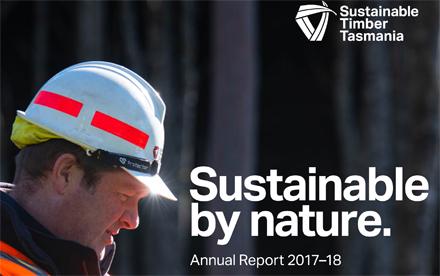
Revenue from the sale of Tasmanian forest products from public land rose by more than 19% last year to $144.86 million, according to Sustainable Timber Tasmania’s annual report. Source: Philip Hopkins for Timberbiz
A $26.6 million increase in the value of the managed forest, plus other income, helped push total revenue in 2017-18 to $211.75 million.
The chairman, Rob de Fegely, said the foundation for a successful 2017-18 was the completion of the forestry right sale of 29,000 hectares of hardwood plantations to Reliance Forest Fibre.
“Proceeds from the sale have enabled us to retire debt and build from a stronger balance sheet and cash position,” he said.
Savings were made by restructuring gains of $4.1 million, rental savings and reduced pension payments to previous employees.
As well, “improved pricing and higher product volumes contributed to stronger revenue”. There were no borrowings.
Mr de Fegely said these and other factors led to a “pleasing” total comprehensive income result of $49 million.
“The 2017-18 result was a step in the right direction towards financial sustainability,” he said.
Total wood production for the year was more than 1.5 million tonnes, with more than 129,000 cubic metres of high quality eucalypt sawlogs supplied to customers.
“Demand for our products was strong and production targets were largely met,” he said.
More than 10,000m3 of special species timbers were supplied. These included Blackwood (9.018m3), celery top pine (541), myrtle (205), blackheart sassafras (190), Huon pine (131), Huon pine craft wood (18), silver wattle (97) and white sassafras (7.7).
Other key wood production categories were: 174,182 tonnes of native forest high-grade domestic peeler; 795,581 tonnes of native forest pulpwood; 162,961 tonnes of hardwood plantation sawlog and pulpwood; and 193,3231 tonnes of softwood plantation sawlog and pulpwood.
A total of $48 million was paid to harvest and haulage contractors, while 47 Tasmanian businesses were supplied.
More broadly, more than 700 of SST’s purchases were paid to 700 Tasmanian businesses, totalling more than $110 million.
Sustainable Timber Tasmania harvested 5727 hectares of native forest and 1596ha of plantation last financial year – less than 1 per cent of the Permanent Timber Production Zone (PTPZ) land of 820,000ha that it administers.
Less than 30 per cent was clear-felled, with more than 70 per cent logged using partial harvesting systems.
Of the 820,000ha, 46.2% is native forests available for wood production, 15.5% is native forests managed for reservation, and 25.3% other native forest.
The latter includes factors such as non-commercial forest, slopes that are too steep, streamside reserves and inaccessibility. The rest of the PTPZ is plantation – 3% hardwood and 0.3% softwood.
Chief executive, Steve Whitely, said more than 6700ha of forest was regrown with more than 300 million seeds.
“Wood production is only part of the story. Regrowing the forest and sustainably managing our land is as important as anything we do,” he said.
Mr Whitely said production was carefully balanced with the ecology of the forest and the species that depend on it. A highlight last year was the collaboration between STT’s forest and modelling experts with external swift parrot experts.
“The combined efforts developed a spatial model to identify swift parrot habitat in the southern public production forests,” he said.
“The outcomes of this work are to be implemented in 2018-19 and will provide greater certainty for wood planning and improve conservation outcomes for the swift parrot.”
The PTPZ has a road network of more than 10,000 kilometres. In 2017-18, Mr Whitely said STT maintained more than 2800km of roads for its operations, and also providing access for recreation, firewood collection or commercial uses such as honey production.






